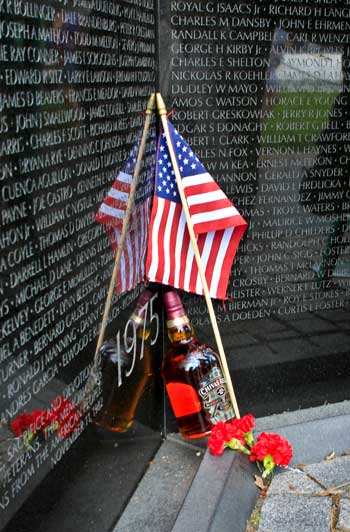How Public Memorials Help Commemorate Loss Through Touch
"Memorials are transitional spaces, which can reduce post-traumatic stress disorder," said Martin Holland, a professor of landscape architecture at Clemson University, at the Environmental Design Research Association (EDRA) conference in Los Angeles. "They are holding environments where people can approach, touch, and see losses in a secure setting." Using two examples — the Vietnam Veterans Memorial in Washington, D.C. and the Oklahoma City National Memorial and Museum in Oklahoma City, Oklahoma — Holland showed how touch is used as a design strategy to commemorate loss.
The Vietnam Veterans Memorial, which opened in 1982, was designed by architect Maya Lin who won the national design competition. It consists of a long black granite wall in an open V shape. The wall is a timeline, with the 58,300 dead listed in chronological, not alphabetical order. This enabled a "social ordering of the space," so visitors could find the name of their loved ones by the year of the conflict.
The names of the fallen soldiers are etched in the wall, which enable rubbings that create "haptic memories." Lin thought that "our primary sense was touch, so she used this as a design strategy."
"Material culture is also used to express grief." People leave flowers, teddy bears, and other objects to commemorate their loved ones. Flowers are often inserted in the wall itself. "It's a palimpsest that changes as people engage with it." All the left objects are periodically swept from the site and archived.
The Vietnam Veterans Memorial set an important precedent for many other memorials, including the Oklahoma City National Memorial and Museum in Oklahoma City. In 1995, a bombing orchestrated by American terrorists brought down a federal office building, killing 168 people and wounding another 680. The blast destroyed or damaged more than 340 buildings in a 16 block radius. Holland explained that approximately one-sixth of all Oklahoma City residents knew someone who died or were affected by the blast, so "for them, it's a local tragedy."
Holland explained that just three days after the bombing, local officials were talking about the need to create a memorial. Over the following years, in one of the "most democratized memorial design processes ever," local officials used surveys and public meetings to gauge what people wanted. The most popular answers were "healing, peace, hope."
In 1997, Berlin-based architects Hans and Torrey Butzer won the Oklahoma City Memorial design competition. While Hans is German, Torrey is from Oklahoma and had a connection with the city and site. They created a memorial that enabled people to touch and interact with objects that commemorated the victims. The memorial has become "the most visited tourist site in Oklahoma City."
Visitors can enter through the Gates of Time. The bomb went off at 9:02. The first gate is marked with the time 9:01, which represents the "last moment of peace," while the gate at the other end of the park is marked 9:03, which represents the "first moments of recovery." Holland argued that the gates "intentionally slow you down, which increases haptic memory."
One of the few trees that survived the blast now has a honored place in the memorial, where it has thrived. The space around the tree is a major gathering space because it's the "only place with shade." Nearby in the memorial, in a place enshrouded in trees, is where Timothy McVeigh parked his bomb-laden car. Holland said this was another example of turning the horrific into the healing.
Each of the 168 victims is memorialized in a chair, which glow from within at night. The chairs for the children victims are smaller. After the official ceremony that opened the park in 2000, victims' loved ones began decorating the chairs, leaving photographs and mementos. What is particularly sad is the "adults remember the children always as children," but there are no photographs of them, for some reason, only toys.
Like the Vietnam Veterans Memorial, all non-perishable materials are periodically collected and archived, which then becomes available for viewing at the museum, except some of the excess teddy bears left at the memorial have been sent overseas to kids in need.
The chairs and the process of leaving mementos are another touch experience that help visitors deal with loss.
Holland argued that some people have called these mementos "kitsch and consumerist," but he wonders if that doesn't reflect some "class bias?"






